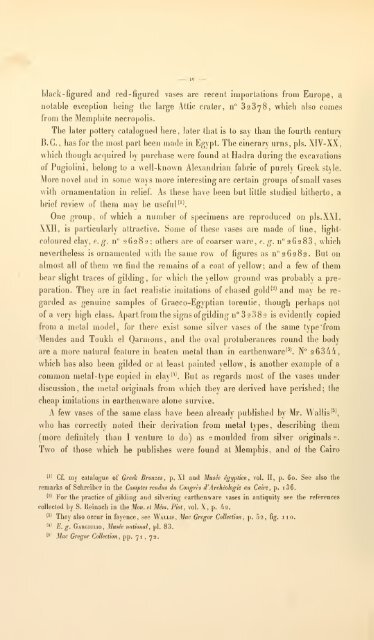Greek vases
Greek vases
Greek vases
Create successful ePaper yourself
Turn your PDF publications into a flip-book with our unique Google optimized e-Paper software.
lack-figured and red-fi|jured <strong>vases</strong> are récent importations from Europe, a<br />
notable exception being the large Attic crater, n° 82 878, which also cornes<br />
from the Memphite necropolis.<br />
The later pottery ealalogued hère, later that is to say ihan the fourth century<br />
B.C., bas for the most part been made in Egypt. The cinerarv urns, pis. XIV- XX,<br />
which though acfjuired by purchase were found at Hadra during the excavations<br />
of Pugiolini, belong to a well-known Alexandrian fabric of purely <strong>Greek</strong> style.<br />
More novel and in some ways more interesling are certain groups of small <strong>vases</strong><br />
\vith ornamentation in relief. As thèse bave been but little studied hitherto, a<br />
brief review of them mav be useful'^'.<br />
One group, of which a number of spécimens are reproduced on pis. XXI.<br />
XXII, is particularly attractive. Some of thèse <strong>vases</strong> are made of fine, light-<br />
coloured clay, e. g. n" 96282 ; olhers are of coarser ware, e. g. n" 26288 , which<br />
nevertheless is ornamented with the same row of figures as n" 26282. But on<br />
almost ail of them we find the remains of a coat of yellow; and a few of them<br />
bear slight traces of gilding, for which the yellow ground was probably a pré-<br />
paration. They are in fact realistic imitations of chased gold*"-* and may be re-<br />
garded as genuine samples of Graeco-Egyptian toreutic, though perhaps not<br />
of a very high class. Apart from the signsof gilding n° 82882 is evidently copied<br />
from a métal model, for there exist some silver <strong>vases</strong> of the same type "from<br />
Mendes and Toukh el Qarmous, and the oval protubérances round the body<br />
are a more natural feature in beaten métal than in earthenware'"''. N° 268/1^,<br />
which bas also been gilded or at least painted yellow, is another example of a<br />
common metal-type copied in clay''*'. But as regards most of the <strong>vases</strong> under<br />
discussion, the métal originals from which they are derived bave perished; the<br />
cheap imitations in earthenware alone survive.<br />
A few <strong>vases</strong> of the same class bave been already published by Mr. Wallis'^^,<br />
who bas correctly noted their dérivation from métal types, describing them<br />
(more definitely than I venture to do) as «moulded from silver originals r.<br />
Two of those which he publishes were found at Memphis, and of the Cairo<br />
''' Cf. my catalogue of <strong>Greek</strong> Bronzes, p. XI and Musée égypiien , vol. II, p. 60. See also the<br />
remarks of Sclireiber in the Comptes rendus du Congrl's d'Archéologie au Caire, p. i36.<br />
('-' For the practice of gilding and silvering earthenware <strong>vases</strong> in antiquity see the références<br />
collected by S. Reinach in the Mon. et Mém. Piot, vol. X, p. i2.<br />
'^' They also occur in fayence, see Wallis, Mac Gregor Collection, p. 5a, fig. 110.<br />
'*' E. g. Gargiulio, Musée national, pi. 83.<br />
'*' Mac Gregor Collection, pp. 71 , 72.

















